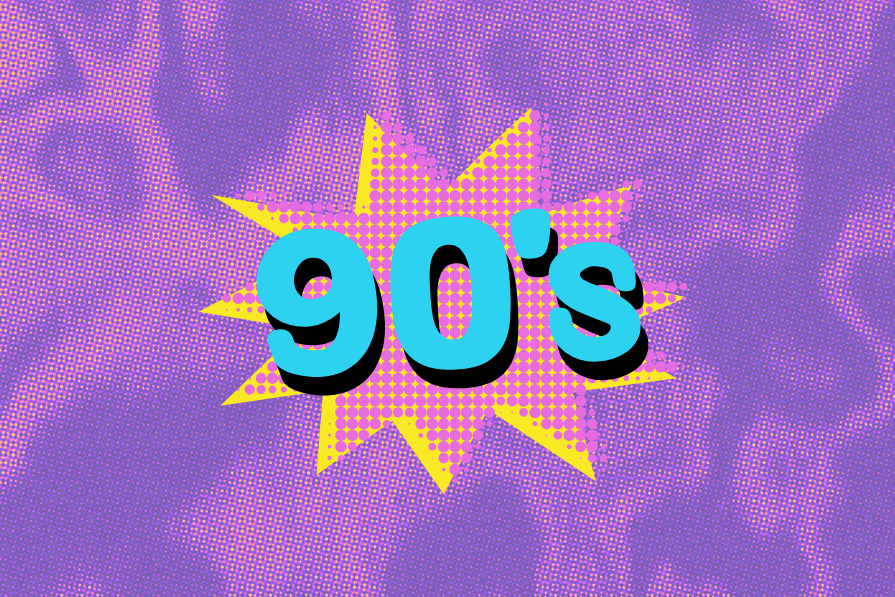What defines 90s website design?
90s website design is defined by an experimental maximalist aesthetic (overloaded pages packed with haphazard information, heavy ornamentation, competing colors, patterns, animations, and textures), constrained by technical limitations and distinguished by quirky, personal creativity.
Core visual traits that defined the 90s web
Core traits that collectively formed the unmistakably vibrant, eclectic, and experimental 90s web aesthetic include:
- Skeuomorphism — A design style where digital elements mimic real-world objects to make interfaces more intuitive and easier to use
- Palettes — Bold, often clashing colors; neon brights like lime green, hot pink, and highlighter yellow; pastel tech tones such as lavender, baby pink, and icy blue; and earthy grunge shades like taupe, maroon, and charcoal
- Typography — Use of system fonts like Arial and Times New Roman with creative sizing, colors, and effects; pixelated and bitmap fonts; experimental mixes for emphasis
- Layout — Table-based grids with dense information, multi-column structures, little whitespace; patterned or tiled backgrounds with geometric shapes and repeating logos often competing for attention
- Animation — Early Flash and GIF animations, cursor trails, marquee text, blinking icons, and whimsical moving elements were used to add interactivity and visual liveliness
- Texture — Textured backgrounds mimicking materials like metal, fabric, or noise/grain; patterns that create depth and visual stimulation beyond flat colors
The cultural context behind 90s web aesthetics
Early web design wasn’t just about visuals. It was about people. DIY homepages, fan communities, and free hosting platforms encouraged self-expression, experimentation, and a sense of belonging, all of which shaped the web’s distinctive personality:
- DIY personal pages — Early web users built their own sites from scratch, often learning HTML through trial and error
- GeoCities and Angelfire — Free hosting platforms democratized web creation, organizing sites into “neighborhoods” based on interests
- Self-expression over polish — Pages were digital diaries, filled with animated GIFs, custom backgrounds, and quirky fonts that reflected personality
- Community-driven content — Guestbooks, mailing lists, and fan pages fostered grassroots networks and niche fandoms
How 90s design shaped modern UX
The experiments of the 90s taught designers what works and what doesn’t. From the visual clutter and poor hierarchy came lessons that led to flat design, responsive layouts, and interfaces that prioritize clarity and function:
Influence on flat design
- Anti-skeuomorphism — Flat design emerged as a direct rejection of visual clutter, prioritizing simplicity, clarity, and two-dimensional elements to achieve speed and elegance
- Focus on function — The illegibility and poor hierarchy caused by 90s maximalism forced modern designers to focus on clear, functional communication (text, basic shapes, intentional color), the core principle of flat design
Modern nostalgia
However, the needle may have swung too far to the other side. By striking a balance, nostalgia can help introduce:
- Personality — Retro elements add a human, emotional texture missing from clinical, purely flat interfaces
- Authenticity — The raw, unfiltered self-expression of early personal sites is the blueprint for modern brands seeking to appear authentic and relatable
- Counter-culture aesthetic — The low-fidelity look of the 90s is now interpreted as a much desired style-quotient against the glossy perfection of mainstream tech, making it a powerful tool for niche branding
Summary card
| Category | Defining 90s Trait | UX design legacy |
|---|---|---|
| Aesthetics | Maximalism: Packed interfaces, where every pixel is decorated by color, texture or animation. | White space negative hierarchy and focus on essential information |
| Structure | Rigid, non-semantic HTML tags used to structure pages | Responsive design where content can “flow” to meet screen size |
| Animation | Wide-spread use of animated GIFs for decoration and buttons | Limited, strategic use of animation to highlight interaction possibilities |
| Typography | Reliance on system fonts and haphazard emphasis techniques | Use of typographic systems and accessibility guidelines |
| Affordance | Heavy use of skeuomorphic 3D buttons and window frames | Simplified, flat design |
By looking back at the experimental energy of the 90s, designers can draw inspiration to create interfaces that are not only functional and accessible but also expressive, memorable, and full of personality.
The post What defines 90s website design? appeared first on LogRocket Blog.
This post first appeared on Read More


